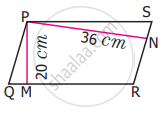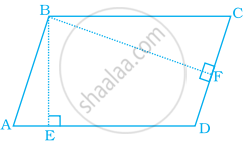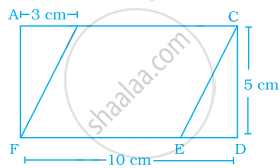Advertisements
Advertisements
प्रश्न
Find the missing value:
| Base | Height | Area of parallelogram |
| 20 cm | ______ | 246 cm2 |
उत्तर
| Base | Height | Area of parallelogram |
| 20 cm | 12.3 | 246 cm2 |
Explanation:
Area of parallelogram = Base × Height
b = 20 cm
h = ?
Area of parallelogram = 246 cm2
20 × h = 246
h = `246/20`
h = 12.3 cm
Therefore, the height of such parallelogram is 12.3 cm.
APPEARS IN
संबंधित प्रश्न
If base of a parallelogram is 18 cm and its height is 11 cm, find its area.
If area of a parallelogram is 29.6 sq cm and its base is 8 cm, find its height.
A parallelogram has sides of 15 cm and 12 cm; if the distance between the 15 cm sides is 6 cm; find the distance between 12 cm sides.
Find the missing values.
| Base | Height | Area |
| 18 cm | 5 cm |
What happens to the area of the parallelogram if the base is increased 2 times and the height is halved?
The base of the parallelogram is 16 cm and the height is 7 cm less than its base. Find the area of the parallelogram
A square and a parallelogram have the same area. If the side of the square is 48 m and the height of the parallelogram is 18 m. Find the length of the base of the parallelogram
In a parallelogram PQRS (See the diagram) PM and PN are the heights corresponding to the sides QR and RS respectively. If the area of the parallelogram is 900 sq.cm and the length of PM and PN are 20 cm and 36 cm respectively, find the length of the sides QR and SR
Area of parallelogram ABCD (see the figure) is not equal to ______.

In the given figure, area of parallelogram BCEF is ________ cm2 where ACDF is a rectangle.

